Held at: | Wellesley College Library |
Reference: | |
Source: | Original Publication |
Title: | Robersons Auction Catalogue: Salvaged rooms from Urishay Castle |
Place name: | Michaelchurch Escley, Golden Valley |
Date: | c.1921 |
Description:
Photographs and transcription of an extract from an auction catalogue issued by Charles Roberson concerning the Jacobean panelled dining room from Urishay Castle. A PDF file of the complete catalogue can be downloaded here.
"HISTORICAL ROOMS FROM THE MANOR HOUSES OF ENGLAND"
By CHARLES L. ROBERSON.
VOLUME I.
Published by
The Mendip Press, Ltd., London & Weston-super-Mare, for
ROBERSONS, THE KNIGHTSBRIDGE HALLS,
KNIGHTSBRIDGE, LONDON.
DIGITISED TEXT:
KNIGHTSBRIDGE HALLS, famous in the West-end of London for so many Public Exhibitions, and notable Official and Social Functions within recent years, have been acquired by Messrs. Robersons for permanent Galleries in which to display the genuine old rooms which come into their possession. They will thus be shown in a way worthy of their beauty and the interest which they afford to collectors. A unique opportunity will also be provided to both Collectors and Owners to acquire or dispose of authentic examples. It is hoped that this book, together with subsequent volumes, will make for Connoisseurs an interesting and valuable record of famous and lesser known old rooms removed from their original situation for preservation elsewhere. In these days when so many of the Estates and County Seats of the Nobility are changing hands, there are many heirloom furnishings, tapestries and art objects which Owners desire to dispose of, and the Knightsbridge Hall Galleries will be an ideal medium through which they may be brought to the notice of possible buyers. Robersons are in intimate touch with Public and Private Collectors, and their Exhibition of “incomparable rarities," both furnishing and decorative, acquired from the Historic Homes of England rivals any to be seen in this country. Among Robersons' purchases of recent years have been the celebrated oak panellings and Grinling Gibbons' carvings from the historic State apartments at Hamilton Palace, including six Oak Panelled Rooms of the Charles II. period, the great Picture Gallery, the Charles II staircase and carved oak balustrading. It will be remembered that this was the largest purchase of antique panellings on record in this country, the sale being held in November 1919, and extending over several weeks. Their more recent purchases include the lease of a London Mansion, together with its entire contents, comprising antique furniture, objets d'art, bronzes, pictures, soft-paste Sevres china, and a pair of well-preserved Gobelin tapestries. These tapestries were from a celebrated English collection and were signed by Lefevre, Director of the Gobelin Works, 1667 to 1736. Also a valuable collection from the sale at Gwydyr Castle, the ancestral home of the Wynn family for nearly five centuries. The cartoons for these tapestries are believed to have been painted by Nattier, one depicting the arrival of Cleopatra in Sicily and the other Cleopatra sitting in state with Antony in attendance upon her. They were in extremely fine preservation and were believed to have been manufactured at the Gobelin Works during their finest period, that is to say, during the early part of the 18th century.
PLAN OF THE EXHIBITION OF HISTORICAL ROOMS FROM THE MANOR HOUSES OF ENGLAND Al' THE KNIGHTSBRIDGE HALLS.
Rooms numbered on the Plan.
No. 1. - Sheldon Hall, the Staircase.
No. 2. - Queen Anne Room from Whitley Beaumont.
No. 3. - Early Georgian Room from an old London House.
No. 4. - Green and Black Lacquered Room.
No. 5. - Old English Pine Room from Grosvenor Square.
No. 6. - Elizabethan Inlaid Oak Room from an Old Manor House in Yorkshire.
No. 7. - Elizabethan Oak Room from Woodbridge, Suffolk,
No. 8. - Early English Renaissance Room from Sheldon Hall, Leicestershire.
No. 9. - Oak Room from the Lower Hall, Liversedge, Yorkshire.
No. 10. - Georgian Pine Room from Leatherhead, Surrey.
No. 11. - Jacobean Oak Room from Swann Hall, Suffolk.
No. 12. - Early Jacobean Oak Room from Urishay Castle.
At the Knightsbridge Halls, we have in these rooms the survival of the fittest craftsmanship of the past centuries, surviving entirely through their merits in workmanship and art. As some literature was written for all time, so the beauty that is inherent in the great periods of furniture and decoration continue to appeal to all ages. The rules which regulate beauty of design are indefinable, but the effects of them appeal to us as they did to our ancestors. Apart from the many old Oak and Pine Interiors which, owing to their beauty and history are known and talked about, and have passed down in unbroken family descent remaining much as they were originally, there are a far larger number continually being revealed by the house-breaker. In the old quarters of London, in the ancient towns and cities of the Shires, and in rural districts far removed from the keen eyes of collectors, there come to light with surprising frequency magnificent specimens of carved and panelled walls, previously lost to sight through old plaster, dirt, and coat on coat of wallpaper or paint. The fascination of the mysterious past, the inherent beauty of the real old work, and the typical old world dignity which they possess, are some of the reasons why those who can afford them are so eager to acquire these old rooms. There is, however, an economic value in them. To decorate in the modern manner, a room worthy of a good home is often as costly as decorating it with the genuine old material of a room centuries old. Wallpaper, Damask, and plaster work will, with constant renovation, last a few years, whilst carved Timber, seasoned with centuries behind it, has still more centuries before it. There is no expense in upkeep, for the more it is left alone the more it will keep its most beautiful feature — the old tone which only time can give it. With the dissolving of the religious houses in England in the 16th century much of the beautiful old woodwork which adorned the habitations of the rich clerics, and the monastic dining halls, and the decorative woodwork of the churches passed into the possession of Court favourites, and made the foundation of many of those magnificent rooms which still exist in the homes of the English Nobility. These stately houses, which seem as enduring as the land itself — so dignified and so opposite to the rush and turmoil of the present — form no small part of our country's character and traditions. It has only been through adversity, such as is brought about by Monarchical change, civil and political strife, that they have been broken up and their contents dispersed. During the troublous times of the Reformation, the distressful later period of Charles the First's reign and even at the present time of exhaustive taxation, when the wealth of the people is drained to meet the financial needs of the nation, many famous examples have been disposed of.
-----------------------------------------
A JACOBEAN OAK ROOM, from Urishay Castle.
THE room has been reconstructed mainly from old panelling removed from Urishay Castle, in Herefordshire. It is of early Jacobean design, and though comparatively simple in detail, it has all the old-world charm of a small manor home of the 17th century. The simple character of the panelling is relieved by the handsomely carved pilasters and the very effective frieze. The ornate chimney piece contains a good deal of fine workmanship, and embraces many characteristic ideas of the Jacobean period.
DETAILS. The room comprises the following: —
1. The whole of the wall panellings, with two window aprons (but no linings or windows).
2. The carved overmantel with panels inlaid with various woods and supported on two carved and fluted pilasters with " linenfold " pedestals.
3. A carved stone opening to fireplace. As the old stone could not be removed, a fine reproduction has been added.
4. The entablature over panelling around room with carved frieze moulding carved and fluted panelled frieze, and modillion cornice.
5. Eight carved fluted and reeded Ionic pilasters on "linenfold " panelled pedestals, and carved Acanthus brackets over same supporting the cornice.
6. The 8 panelled half door, with ornamental wrought iron latch and hinges.
The size of this room is approximately :— Length, 20ft. 7ins. ; width, 19ft. 4ins. ; height to top of oak cornice, 8ft. 2ins.
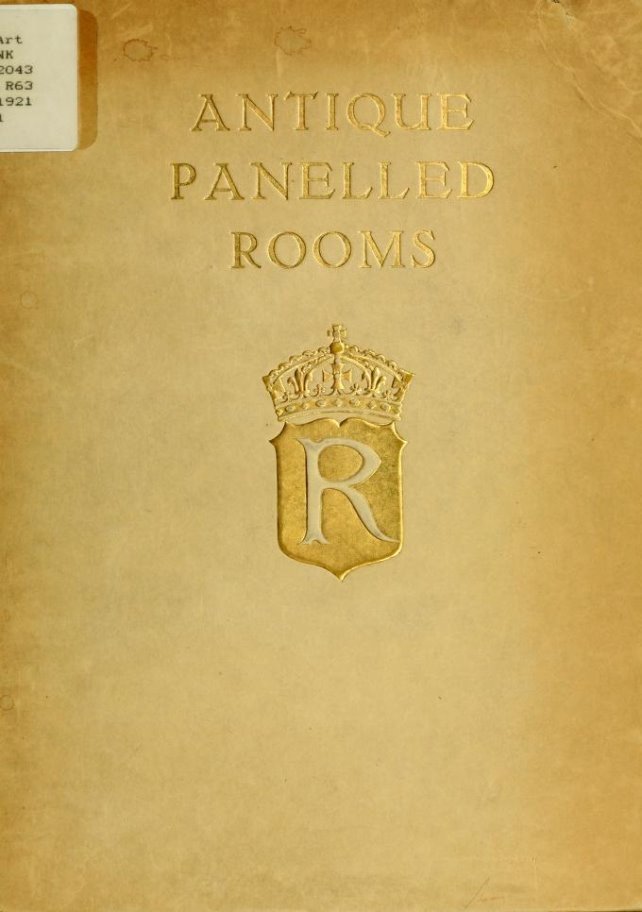
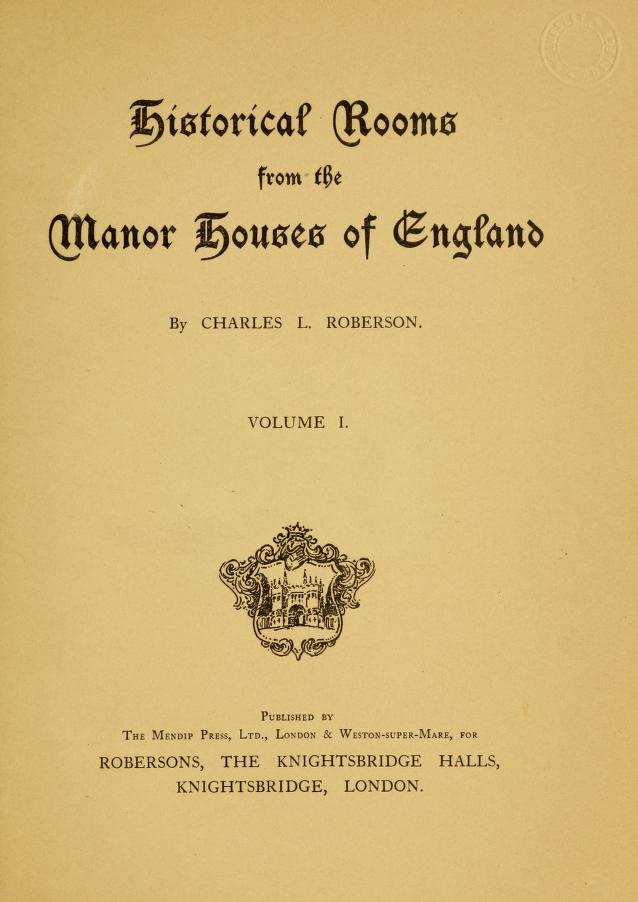
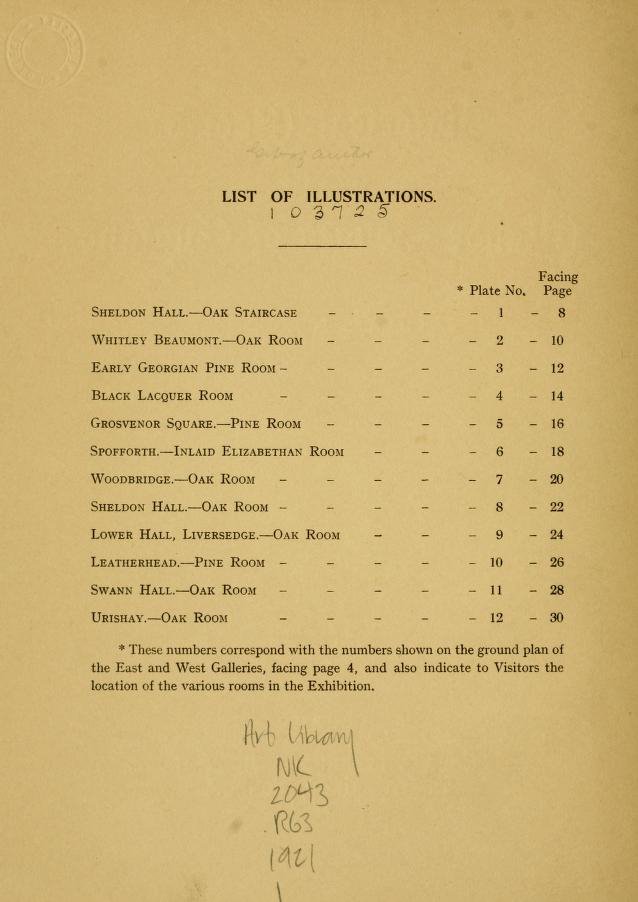
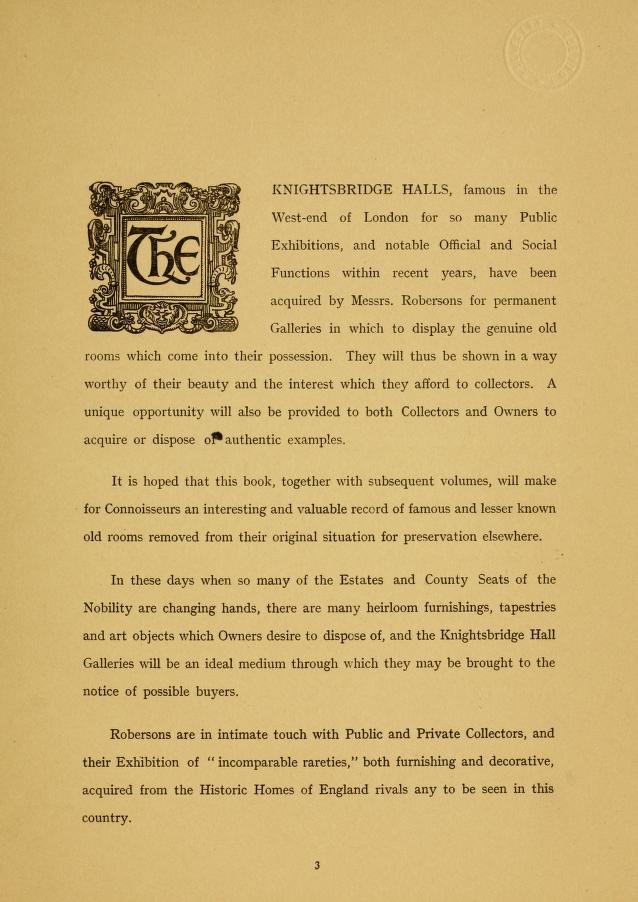
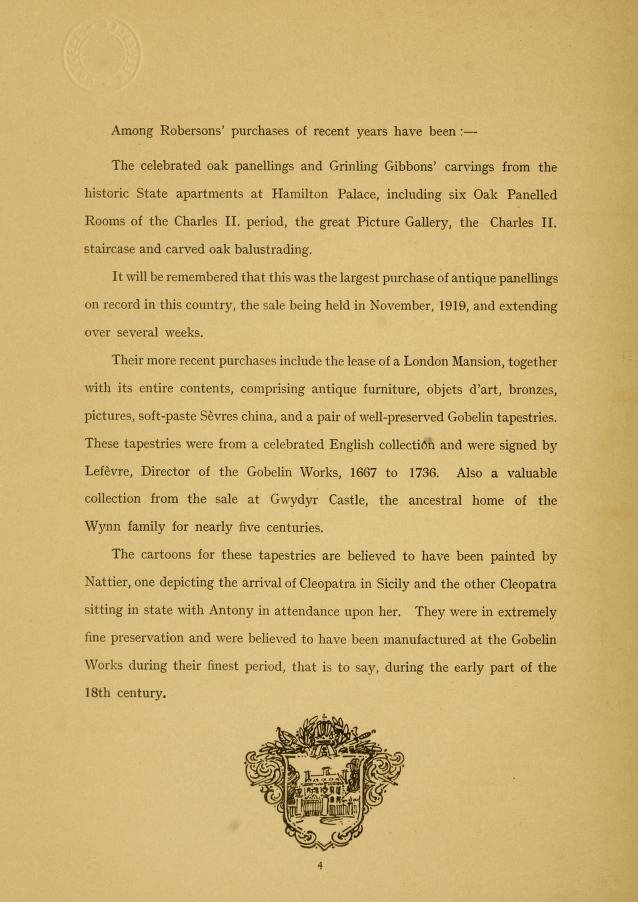
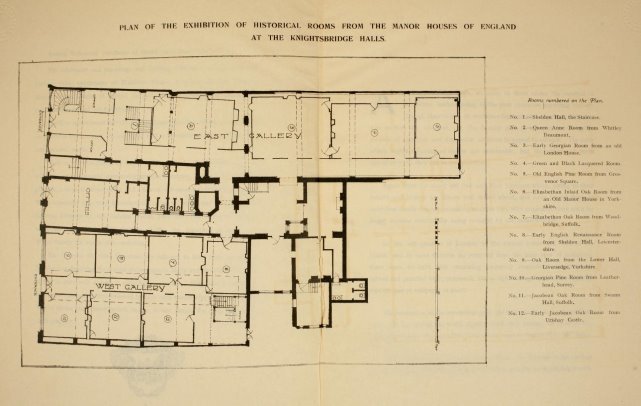
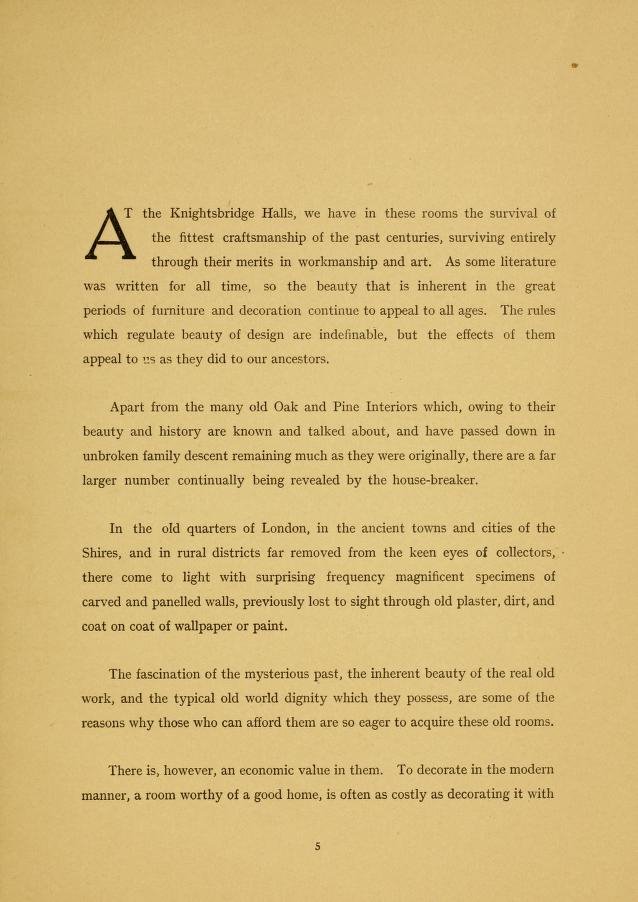
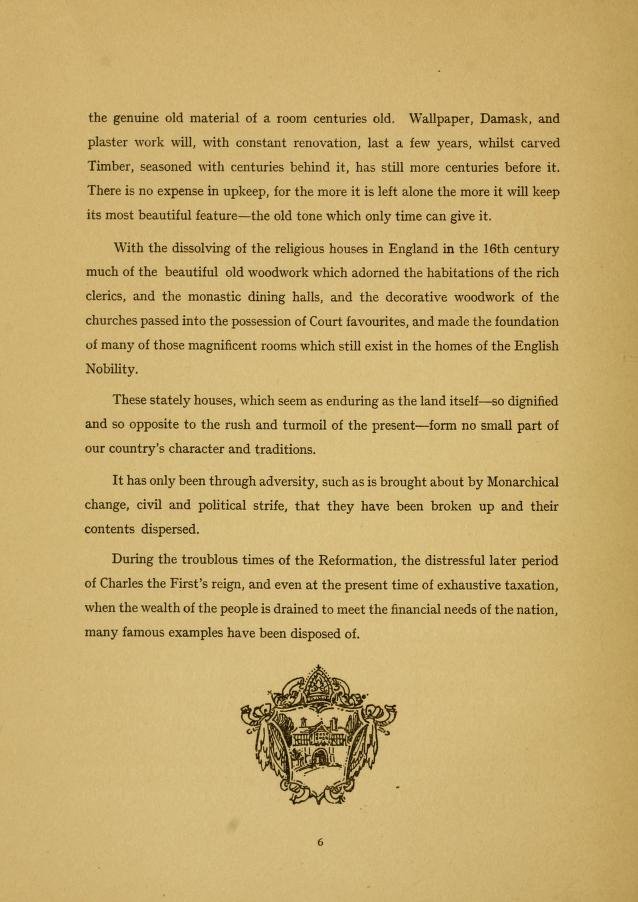
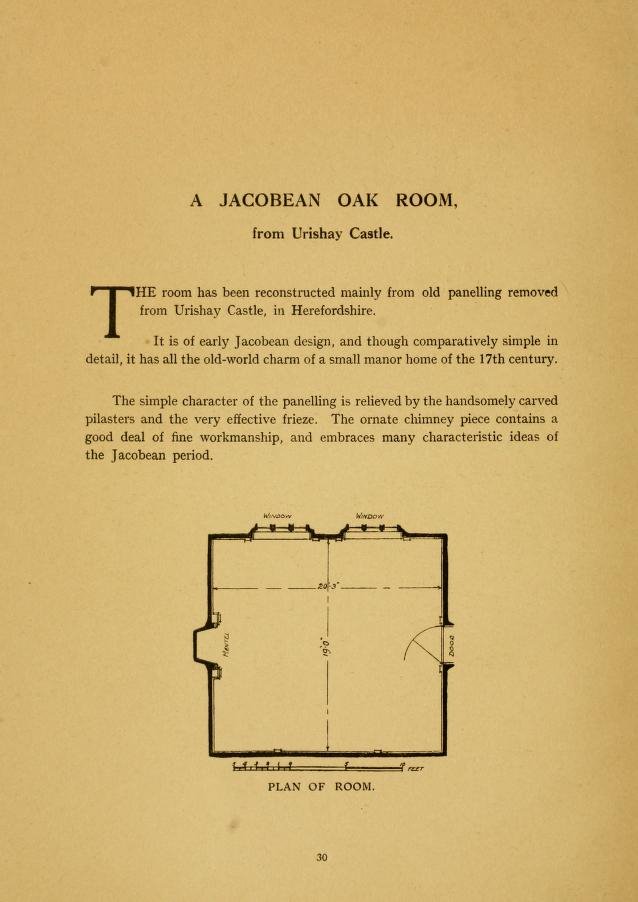
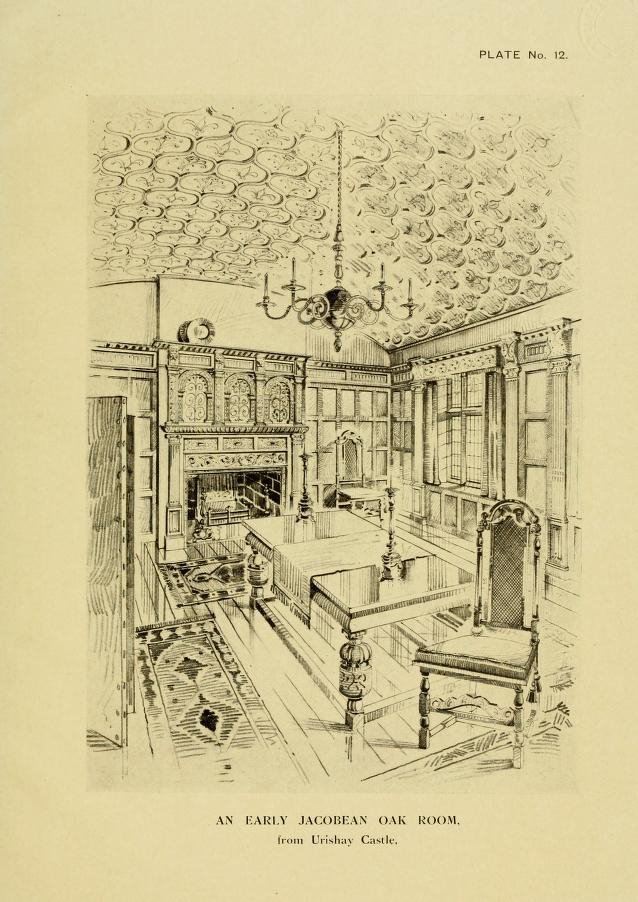
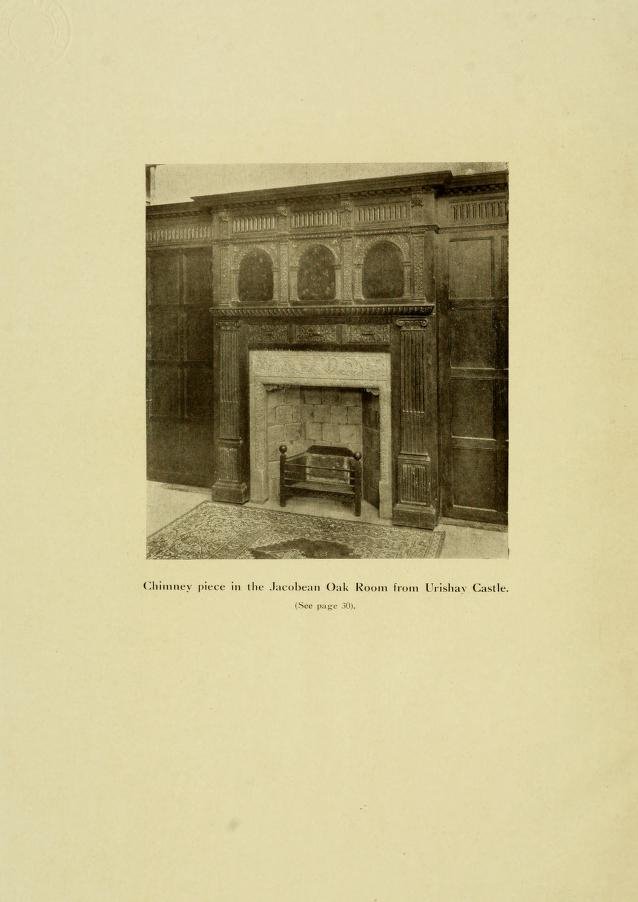
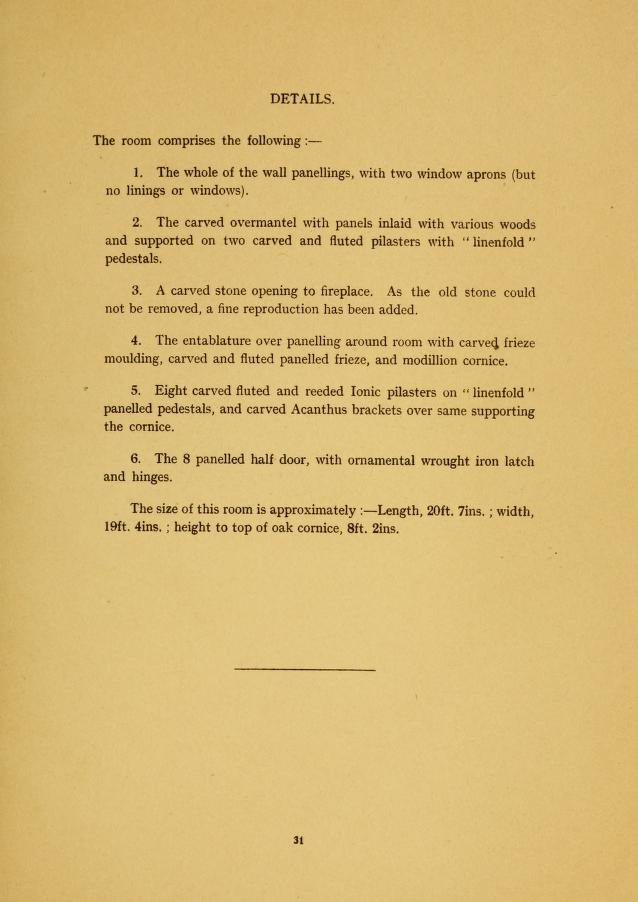
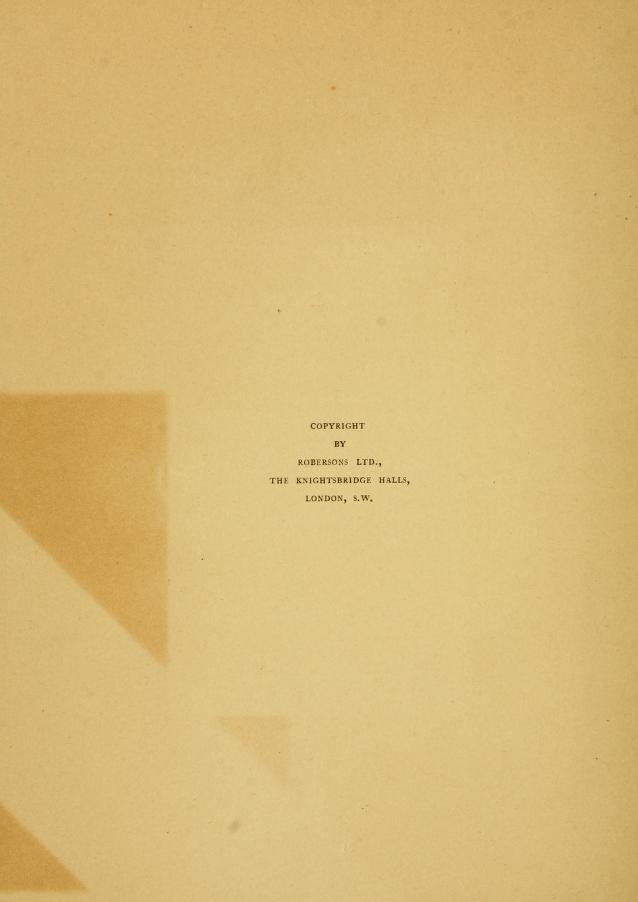
Observations:
Although this publication is presented as a book, it is in effect a Sale Catalogue containing particulars of a variety of rooms offered as architectural salvage. Particulars of all the lots on offer are given in the book, but only the details for the Urishay Castle entry are included here, since the others fall outside our geographic focal area.
Two panelled rooms were salvaged from Urishay Castle between 1913 and 1921 - the Drawing Room and the Dining Room. They are both believed to have been acquired and sold by Robersons, who were London-based dealers in the early part of the twentieth century specialising in antique rooms from English country houses. Photographs of the Urishay Castle Drawing Room as it is preserved today in the United States of America are available elsewhere on this website. A variety of other material describing its history and its fascinating journey from the Golden Valley to its current resting place at Baker University in Kansas is also available in the Baker University Collection.
The photograph and sketch of the room shown in the Roberson booklet above show features quite different from the Drawing Room, and the dimensions are significantly smaller. This is therefore presumed to be the Urishay Castle Dining Room, which some sources suggest may have been purchased from Roberson to form part of the restoration of Brayne Court in Gloucestershire in the 1920s.
There is no reference to the Urishay Drawing room – a larger and more significant item – in this or in the subsequent three Volumes issued by Robersons in the period up to about 1925. It is therefore probable [though not certain] that the drawing room was auctioned by Robersons [who had established themselves as the leading specialists in this kind of architectural salvage around 1910] before their 1920 move to Knightsbridge Halls. Logic would suggest the most attractive and valuable lot would be put forward first by the Delahay vendors; these factors suggest a likely disposal date of the drawing room of 1913 or 1914, shortly after the initial attempt to sell the Urishay Estate in 1913. This seems to be supported by the reported use of the room by Marshall Fields in Chicago for some years before its acquisition by the Chicago Arts Institute in 1921.
It is possible a third room - a Study - from Urishay Castle was also salvaged around the same time and may have been sold by Roberson. Only one passing reference to this has been found, and no other information is currently available. The original records from Robersons auction house in Knightsbridge are said to have been destroyed in a fire, and the study may not have been significant enough to earn a place in the printed catalogues.
Ref: rs_mic_0344
